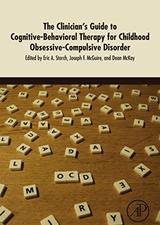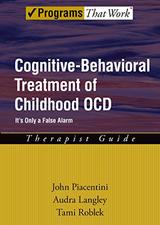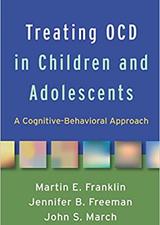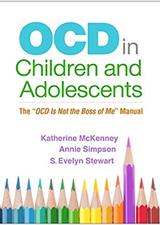
Obsessive Compulsive Disorder
The resources below contain training information and manuals about cognitive behavioural therapy for OCD.
International OCD Foundation Training Institute
Behaviour Therapy Training Institute (BTTI) was launched in 1995 to meet the needs of health care professionals. The IOCDF Training Institute was created to offer a more comprehensive curriculum of professional training opportunities, and to address a variety of specialties and issues pertaining to the OCD and related disorders community, while also providing continuing education credits to qualified professionals.
The IOCDF Training Institute curriculum is formatted in the style of higher education course catalogs, ranging from the 100-level basic trainings and to the 400-level advanced trainings


The Clinician's Guide to Cognitive-Behavioral Therapy for Childhood Obsessive-Compulsive Disorder
The Clinician's Guide to Cognitive-Behavioral Therapy for Childhood Obsessive-Compulsive Disorder by Eric A. Storch, Joseph F. McGuire, Dean McKay (Editors) provides novel cognitive behavioral strategies and considerations that therapists can immediately put into practice. The book provides case studies and example metaphors on how to explain exposure models to children in a developmentally appropriate manner. The book also instructs clinicians on how to use symptom information and rating scales to develop an appropriate exposure hierarchy. The book is arranged into two major sections: assessment and treatment of childhood OCD and special considerations in treating childhood OCD.

Cognitive-Behavioral Treatment of Childhood OCD: It's Only a False Alarm
Cognitive Behavioral Treatment of Childhood OCD by John Piacentini, Audra Langley, Tami Roblek is a therapist's guide, outlining a 12-session CBT-based treatment for OCD that benefits not only children and adolescents, but their families as well. Each session incorporates a family therapy component in addition to individual treatment for the child. It is a combined approach program that educates the child and family about OCD in order to reduce negative feelings of guilt and blame and to normalize family functioning. This manual also provides guidelines for conducting both imaginal and in vivo exposures, techniques at the core of helping children reduce their anxiety. For use with children ages 8 to 17, this book is an indispensable resource for clinicians helping children and their families cope with OCD.

Treating OCD in Children and Adolescents: A Cognitive Behavioral Approach
Treating OCD in Children and Adolescents: A Cognitive Behavioral Approach, by Martin E. Franklin, Jennifer B. Freeman and John S March, is an authoritative work offering a framework for helping children overcome obsessive–compulsive disorder (OCD) using the proven techniques of cognitive-behavioral therapy (CBT). Therapists gain knowledge and tools to engage 6 to 18 year-olds and their parents and implement individualized CBT interventions, with a focus on exposure and response prevention. In a user-friendly, conversational style, the authors provide real-world clinical guidance, illustrated with vivid case examples. Purchasers get access to a Web page where they can download and print the volume's reproducible handouts in a convenient 8 1/2" x 11" size. Building on the earlier OCD in Children and Adolescents: A Cognitive-Behavioral Treatment Manual (by John March and Karen Mulle), this book reflects two decades of advances in the field; most of the content is completely new.

OCD in Children and Adolescents: The "OCD Is Not the Boss of Me" Manual
OCD in Children and Adolescents: The "OCD Is Not the Boss of Me" Manual, by Katherine McKenney, Annie Simpson and S. Evelyn Stewart, is a user-friendly manual and comes in a large-size format for easy photocopying. The Manual presents a tested treatment protocol for children and adolescents (ages 6 to 18) struggling with obsessive–compulsive disorder (OCD). Ten flexible modules give clinicians tools for engaging kids and their parents and implementing successful exposure and response prevention activities, as well as other cognitive-behavioral therapy (CBT) strategies. Each module includes vivid clinical vignettes, sample scripts, “tips and tricks” drawn from the authors’ extensive experience, and numerous reproducible child and parent handouts and worksheets. Purchasers get access to a Web page where they can download and print additional copies of the reproducible materials, in color.

